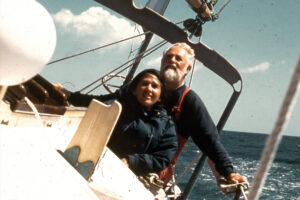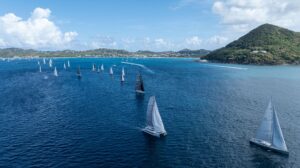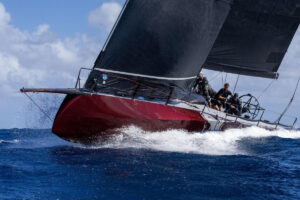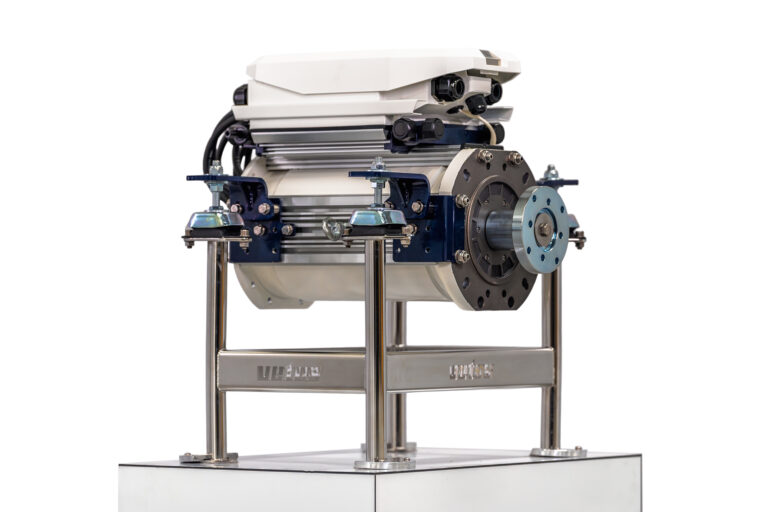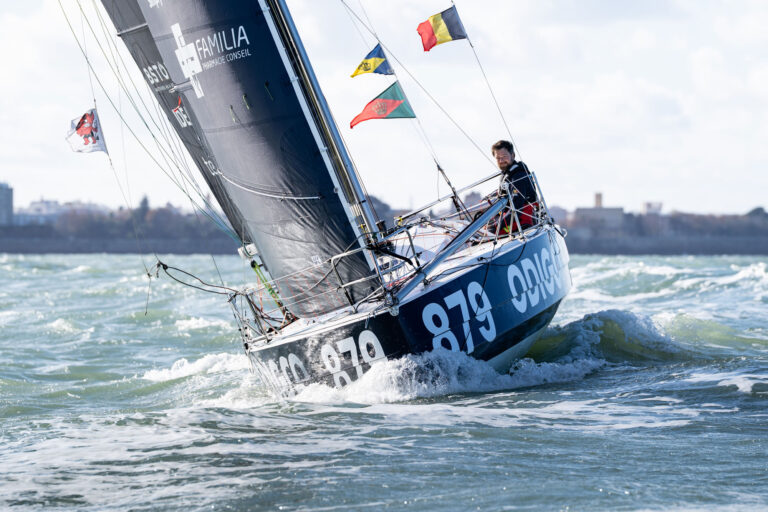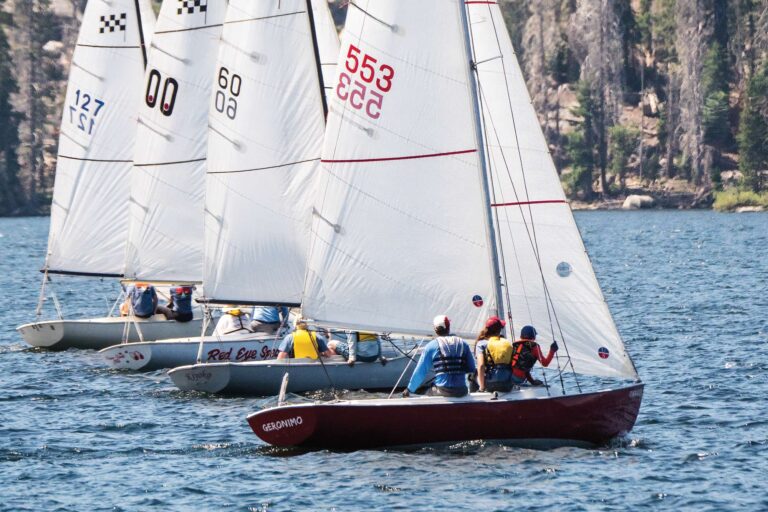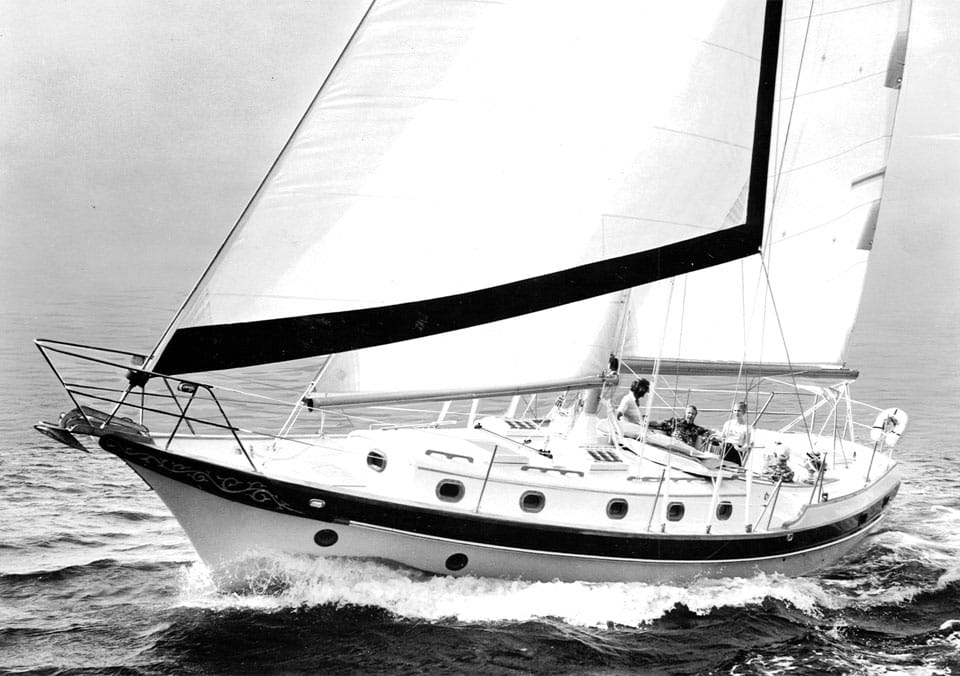
best-sailboat-csy-44.jpg
Originally conceived as a bareboat charter vessel, the CSY 44 was a ruggedly built mid-cockpit cutter also available in a pilothouse version. But the hefty lay-up schedule, moderate sail area and full hull sections made it as appealing to cruising traditionalists as it was to the charter fleet. The boat was available ready to cruise or in a kit version, which broadened its appeal. Click here to read more about the CSY 44.
The CSY 44 evolved from a desire to build a better charter boat, hard to break, easy to care for, more livable at anchor and more responsive under sail. The result didn’t look anything like the thoroughbreds dominating Antigua Race Week today. Instead, a retro look, starting with the clipper bow and molded-in trailboards, caused many to assume that this might be just another full-keel anachronism dependent on the enhanced trade winds of the Caribbean for any measure of sailing ability. Charterers and new-boat owners were pleasantly surprised.
The CSY 44 turned out to be a ruggedly built mid-cockpit cutter also available in a pilothouse version. The hefty lay-up schedule, moderate sail area and full sections made it as appealing to cruising traditionalists as it was to the charter fleet. Her bulletproof rub rail and a keel and ballast arrangement designed to handle a grounding piqued the interest of many cruisers. The fact that the vessel could be purchased in kit form or as a ready-to-cruise package further widened its appeal.
The CSY 44’s clipper bow, raised deck aft and relatively high freeboard do give her a distinctive look. The smooth curve of the cove band and boot stripe work together to offset the freeboard astern and thus lower the profile of this big, broad-transomed boat. Making a boat spacious below results in some extra windage and water-dragging girth, but in this case the end justifies the means, especially if you want to stow a lot of gear.
On one hand, the designers set out to create a big boat with lots of room below, plenty of waterline length and a good amount of volume for tankage, storage and headroom. On the other hand, tank testing helped make the hull form as efficient as possible. The underbody, characterized by a cut-away forefoot, longish keel and skeg-hung rudder, affords plenty of directional stability and performs reasonably well under sail on and off the wind.
The boat comes in either a shoal- (4’ draft) or deep-keel (6’ draft) version. Long-distance passage makers would probably be better off with the deep-draft version, because the shoal option is virtually the same, with the bottom two feet and 2,000 pounds of ballast keel lopped off, reducing significantly the vesselÕs ultimate righting moment. The shoal-draft model, however, would be a great coastal passage maker, particularly adapted to the Bahamas, Florida Keys and ICW.
The no-nonsense single-spreader cutter rig is well supported by 1×19 wire attached to formidable chain plates. The main is less than 400 square feet and is easy to reef; its long foot makes it a strong driver on and off the wind. The overlapping jib topsail can be roller furled and tips in at just under 500 square feet. It is a high-cut sail, providing good visibility to leeward yet substantial power. Typical of all traditional cutters, the unsung hero of this sailplan is the 200-square-foot inner forestaysail flown from a self-tending club-foot boom.
The Standard Perkins 4-154 has proven a reliable power plant for the prop and a big alternator and/or refrigerator compressor. Capacities of 400 gallons for water and 100 gallons for fuel were an intelligent balance for tropical tradewind cruising where the breeze is constant and water difficult to come by.
Interesting factory options included less water tankage and the addition of an Onan diesel generator, watermaker and air conditioner. Twenty-year-old boats equipped with these original components should be surveyed carefully in order to discern if there is any life left in them, if they have been upgraded, and if not, how costly it would be to do so. Gear such as solid bronze ports, a Paul Luke stove, a tinned wire harness and Edson rack-and-pinion steering are indicators of a boat that’s built to last.
Anybody looking for a rugged, well built, comfortable cruising boat, one decidedly worth renovating, should take a close look at the CSY 44. Hulls that have been ridden hard and put away wet in the charter trade are bargain priced at around $80,000 – $95,000, and they represent a good buy for the handy do-it-yourselfer. A pampered, professionally maintained version that is well equipped and pretty much ready to go, may be priced around $95,000 – $110,000.
CSY 44 Specifications:
* LOA: 44’0″ (13.4 m.)
* LWL: 36’4″ (11.1 m.)
* Beam: 13’4″ (4.1 m.)
* Draft (deep): 6’6″ (2.0 m.)
* Draft (shoal): 4’11” (1.5 m.)
* Ballast (deep): 12,000 lbs. (5,443 kgs.)
* Ballast (shoal): 10,000 lbs. (4,536 kgs.)
* Disp (deep): 33,000 lbs. (14,969 kgs.)
* Disp (shoal): 31,000 lbs. (14,062 kgs.)
* Sail area: (100%) 906 sq.ft. (84.2 sq.m.)
* Mast above water: 55’0″ (16.8 m.)
* Ballast/Disp: .32 (shoal), .36 (deep)
* Disp/Length: 288 (shoal), 307 (deep)
* SA/Disp: 14.7 (shoal), 14.1 (deep)
* Fuel: 100 gal. (379 ltr.)
* Water: 400 gal. (1,514 ltr.)
* Holding: retrofit
* Auxiliary: Perkins 4-154 diesel
* Cabin headroom: 6’7″ (2.0 m.)
* Designers: Frank Hamlin, Peter Schmitt
The CSY 44 is included in CW‘s list of the 40 Best Sailboats of All Time. Click here to see the other boats in the list.

